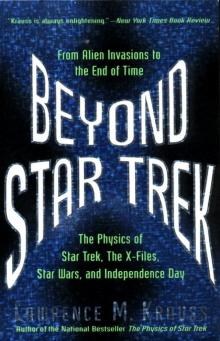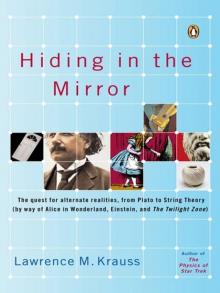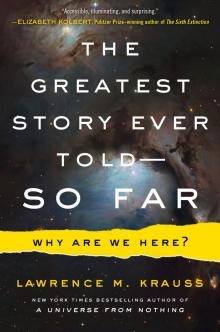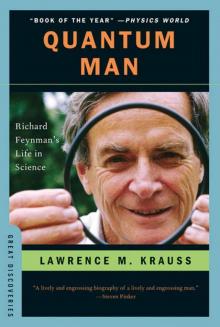- Home
- Lawrence M. Krauss
Quantum Man: Richard Feynman's Life in Science Page 14
Quantum Man: Richard Feynman's Life in Science Read online
Page 14
With the completion of Dyson’s two papers, QED was truly tamed. It could now rise to the ranks of “theory” in the best scientific sense of being a logically consistent formalism that made unique predictions which could be and had been successfully compared with experimental results.
Interestingly, Dyson’s original paper proving the equivalence of Schwinger’s and Feynman’s pictures contained only a single space-time diagram. Yet, as Feynman’s seminal papers on his own results had not yet appeared, the first “Feynman diagram” in print was actually Dyson’s.
It is hard to overstate the importance and impact of Dyson’s work. He became almost an immediate celebrity in the physics community—but more importantly, his work led others, who could not understand or were dubious about Feynman’s diagrammatic approach, to learn the formalism and begin to adopt it. While Feynman’s own exposition of his work would come in seminal papers written in 1949 and 1950, it was Dyson’s papers as much as anything that provided the window through which Feynman’s ideas were able to change the way physicists thought about fundamental physics.
Dyson worked hard, perhaps harder than Feynman did, to convince the rest of the world of the utility of Feynman’s ideas. Indeed, much of the subsequent use of Feynman diagrams by physicists in the decade following Feynman’s work can be traced to the influence of Dyson, who, through his personal contact with Feynman, had become his number one disciple.
Dyson’s papers ultimately reflected his view that while Feynman’s and Schwinger’s and Tomonaga’s approaches were equivalent, Feynman’s was the more enlightening and useful to those who would want to use QED to solve physics problems.
As the tide of interest began to shift away from Schwinger, he was not unaware, and later remarked, “There were visions at large, being proclaimed in a manner somewhat akin to that of the Apostles, who used Greek logic to bring the Hebrew god to the Gentiles.” Schwinger later issued another backhanded compliment, which was perhaps even more characteristic of his view that enlightenment should be obtained only by those willing to toil the hardest: “Like the silicon chip of more recent years, the Feynman diagram was bringing computation to the masses.”
The historian David Kaiser has studied the “dispersion” of the Feynman diagrammatic approach within the physics community in the years immediately prior to and following the publication of his work. As Kaiser has shown, the growth was exponential, with a doubling time of about two years, and by 1955 about 150 papers included Feynman diagrams. What began as a curiosity understood by Feynman and a few colleagues at Cornell, and then by way of Dyson and others at the Institute for Advanced Study and elsewhere, continued on to become a technique that has appeared since in every volume of the Physical Review, the standard reference journal in the field. What started out as an effort to handle QED is now used in virtually every field of physics.
Feynman and Dyson in fact had a very different understanding of his diagrams. Feynman, influenced by his own space-time pictures, his sum-over-paths formalism, and his insistence on thinking about particles in motion rather than quantum fields, thought of the diagrams as real pictures of physical processes, where electrons would bounce around from place to place and from time to time (both forward and backward). Based on these pictures he wrote down formulas, and he could then check to see if they would produce the correct answers. It really was a bootstrap approach, without much fundamental basis other than his remarkable intuition.
Dyson’s work changed all that. He demonstrated how the diagrams could follow from fundamental sets of equations based on quantum field theory. For Dyson each part of each diagram represented a well-defined term in a series of equations. The diagrams were a crutch to help elucidate the equations, and the “Feynman rules” associated for translating the diagrams into equations were not ad hoc, as Feynman had invented them, but rather could be justified by well-defined manipulations of equations associated with quantum mechanics and special relativity. For this reason perhaps the adoption of Feynman diagrams occurred more quickly than the adoption of Feynman’s path-integral space-time approach to physics—which, as we will see, would take another several decades to fully change the physics landscape.
Dyson had immediately appreciated how Feynman’s methods could help mere mortals systematically perform the complex calculations of quantum field theory. As he later described in a memoir, “The calculation I did for Hans Bethe using the orthodox theory took me several months of work and several hundred sheets of paper. Dick Feynman could get the same answer, calculating on a blackboard, in half an hour.”
Feynman’s own epiphany, when he knew he had discovered something truly outstanding, occurred during the January 1949 New York meeting of the American Physical Society, the very same meeting where Dyson was feted for his work by, among others, Robert Oppenheimer during his presidential address. At the time, when essentially all of the active research physicists in the country could fit in a single large hotel, the January event had become perhaps the most important physics meeting in the world. In 1949 the mood was particularly celebratory, as physicists had at last begun to see through the fog of infinities to understand electrodynamics as a workable quantum theory. Moreover, with the development of the first significant particle accelerator, Berkeley’s 184-inch cyclotron, a plethora of new elementary particles interacting under the strange strong force were being created “under controlled conditions and in large numbers,” as Feynman then described it in a review he wrote in 1948 for the new journal Physics Today. The excitement about this strange new world of phenomena, and the hope that the new methods that had been developed to deal with QED might shed light on it, were palpable. The catalyst for Feynman’s enthusiasm came not from discussions about QED itself, but rather from a debate about the interactions of the newly created particles called mesons.
A young physicist, Murray Slotnick, had used the pre-Feynman methods of calculating in quantum field theory to determine, in a herculean effort, the effects these new types of particles might have if they were exchanged as virtual particles between neutrons in nuclei and electrons orbiting around them. He had discovered that only one type of possible interaction would produce finite results, which he then calculated. Slotnick presented his work at a session of the meeting.
After his presentation, Oppenheimer got up and, in his typical fashion, swiftly and harshly dismissed Slotnick’s results. Oppenheimer claimed that a postdoctoral researcher at the institute had proved a general theorem that all of the different possible meson interactions would end up having the same effects on neutron-electron interactions, a result that was in manifest disagreement with Slotnick’s claim.
Feynman apparently arrived after this session, but he was informed of the new controversy and asked to comment on his perception of who was correct. Up to this point Feynman had not done any theoretical calculations with mesons, but that evening, after someone explained to him what the theories were about, he translated his QED methods in this new context, and spent several hours calculating the various different possible meson theories. In the morning he compared his results with those of Slotnick, who had actually performed his calculation only in a special limit of the theory. Feynman had done the calculation in full generality, but when he took the same limit, his results agreed with Slotnick’s.
Slotnick, who no doubt was reassured by Feynman’s result, was also astonished. He had spent almost two years formulating and completing a calculation that Feynman did in a single evening. For Feynman, this realization was intoxicating. It was then, and only then, that he realized the true power of his new techniques. As he later said, “This is when I really knew I had something. I didn’t really know that I had something so wonderful as when this happened. That was the moment that I really knew that I had to publish—that I had gotten ahead of the world. . . . That was the moment when I got my Nobel prize when Slotnick told me that he had been working two years. When I got the real prize it wa
s really nothing, because I already knew I was a success. That was an exciting moment.”
For good measure, when Oppenheimer’s postdoctoral colleague gave his paper the next day, Feynman couldn’t resist goading Oppenheimer. After the postdoctoral researcher in question, named Case, gave his presentation, Feynman got up and stated, offhandedly, that it had to be wrong because, as he now was able to say about Slotnick’s work, “a simple calculation shows that it’s correct.”
This incident not only lit the fire necessary to convince Feynman he had to publish his results, but also forced him to develop the tools that allowed him to present his work in a fashion in which the rest of the community could understand it. In the first place, Feynman now felt obliged to understand what Case had done wrong. But to do that, he had to understand exactly what Case had done, which was difficult for him since Case had used the traditional techniques of quantum field theory that Feynman had ignored up to that point. In learning these techniques, from a graduate student at Cornell, Feynman was able not only to uncover Case’s mistake, but also to reap an additional dividend from his investment of time: he was finally able to understand vacuum processes in a way that had earlier eluded him. His new understanding played a vital role in the presentation in the first of his epic QED papers, “The Theory of Positrons.”
Next, with his newfound familiarity with meson theories, which were all the rage then, Feynman was able to formulate his diagrammatic rules for these theories and quickly reproduce every result that other physicists had derived over the years. These results were summarized in his next classic paper, “Space-Time Approach to Quantum Electrodynamics,” no doubt raising its interest among the host of physicists who were struggling to make sense of these new strongly interacting particles.
As he had been urged at the Pocono Conference, where he had so deeply bungled his presentation, he decided to first publish his computational diagrammatic methods in a coherent fashion, and then the formal mathematical underpinnings later. Recognizing that his space-time approach “came from too far away,” the introduction to his paper reads, “The Lagrangian method . . . was modified in accordance with the requirements of the Dirac equation and the phenomenon of pair creation. This was made easier by the reinterpretation of the theory of holes. Finally for practical calculations the expressions were developed in a power series. . . . It was apparent that each term in the series had a simple physical interpretation. Since the result was easier to understand than the derivation, it was thought best to publish the results first in this paper.”
While minimizing the theoretical and mathematical motivations in this initial exposition, which he realized could not “carry the conviction of truth which would accompany the derivation,” Feynman nevertheless made clear to the reader the significant advantage of his methods. When comparing his space-time approach with the more traditional “Hamiltonian” approach for dealing with the relativistic Dirac theory—as opposed to the nonrelativistic Schrödinger theory—he wrote, “As a further point, relativistic invariance will be self-evident. The Hamiltonian form of the equations develops the future from the instantaneous present. But for different observers in relative motion the instantaneous present is different, and corresponds to a different 3-dimensional cut of space-time. . . . By forsaking the Hamiltonian method, the wedding of relativity and quantum mechanics can be accomplished most naturally.”
Over the next year, Feynman completed the remaining two papers necessary to give a thorough and more formal derivation of his results—using a new type of calculus he had developed—and to demonstrate formally the equivalence of his techniques with those of conventional quantum field theory. With the publication of Feynman’s four papers, the QED story was now essentially complete. What had started out as a desire, when he was a graduate student, to reformulate QED as a theory without any infinities, had instead developed into a precise and astoundingly efficient methodology for working around infinities to obtain results that could be compared with experiments.
The contrast between hope and reality was not lost on Feynman. Throughout his four papers, while acknowledging the achievement they represented, he conveyed a palpable sense of disappointment. In “Space-Time,” when comparing his computational techniques with Schwinger’s, for example, he wrote, “Although in the limit the two methods agree, neither method appears to be thoroughly satisfactory theoretically. Nevertheless it does appear that we now have a complete and definite method for the calculation of physical processes to any order in quantum electrodynamics.”
For many years, right up to and including the time, in 1965, when he was awarded the Nobel Prize for his work, Feynman felt that his methods were merely useful, not profound. He had not unveiled fundamental new properties of nature that would rid the theory of infinities, but had found a way to safely ignore them. The real hope—that path integrals would produce the revelations in our basic understanding of nature that he had hoped would cure the ills of relativistic quantum physics—he felt, had not materialized. As he said to a student newspaper on the day the Nobel Prize was announced, “It was the purpose of making these simplified methods of calculating more available that I published my paper in 1949, for I still didn’t think I had solved any real problems. . . . I was still expecting that I would some day come through the other end of my original idea . . . and get finite answers, get that self-radiation out and the vacuum circles and that stuff straightened out . . . which I never did.” And as he later described it in his Nobel address: “This completes the story of the development of the space-time view of quantum electrodynamics. I wonder if anything can be learned from it. I doubt it.”
History would ultimately prove otherwise.
PART II
The Rest of the Universe
Today we cannot see whether Schrödinger’s equation contains frogs, musical composers, or morality—or whether it does not. We cannot say whether something beyond it like God is needed, or not. And so we can all hold strong opinions either way.
—RICHARD FEYNMAN
CHAPTER 11
Matter of the Heart and
the Heart of Matter
What I am trying to do is bring birth to clarity, which is really a half-assedly thought-out pictorial semi-vision thing.
—RICHARD FEYNMAN
Richard Feynman did not lay down his sword in 1949. He had achieved something wonderful, but even he didn’t realize its full extent. In the meantime, nature continued to beckon. And for Feynman, being interested in physics meant being intensely curious about all aspects of the physical world, not just a single exciting frontier. The completion of his magnum opus on QED also coincided with a more personal and more difficult transition for him, from his beloved Cornell to the excitement and allure of more exotic climes.
As unconventional as Feynman was in his behavior and his way of dealing with social norms, he remained in those postwar years strangely provincial. I have already mentioned his early disinterest in classical music and the arts. And while he might have seemed worldly, largely through his wartime experience and his dealings with colleagues from other countries, by the age of thirty-one he had never ventured outside the shores of the continental United States. That would soon change.
Feynman’s mind was always searching for new problems and new intellectual challenges. This predilection crept into his personal life as well. He once said to me, “One should seek out new adventures wherever one can.”
I suspect that after the intense effort between 1946 and 1950 wrestling with QED, Feynman’s mind now wanted to move far afield, not just in topic, but in style. Emotionally restless and unhappy, and yearning for adventure, Feynman wanted to escape the confines of gloomy wintery Ithaca, and perhaps the many tense sexual entanglements he had gotten embroiled in. Sunny California beckoned, but South America seemed even more enticing.
Like many key life decisions, this one involved a bit of serendipity. An old
Los Alamos colleague, Robert Bacher, was moving to Pasadena, to rebuild a dormant physics program at Caltech, and he immediately thought of Feynman. He called him at the right time. The man who had previously turned down Princeton, University of Chicago, Berkeley, and a host of other institutions agreed to visit Pasadena. At the same time, Feynman’s imagination was drifting even further. He had decided, for some reason, to visit South America, and had started to learn Spanish when a visiting Brazilian physicist invited him to Brazil for the summer of 1949. Feynman quickly accepted, got a passport, and switched to learning Portuguese.
He lectured on physics at the Centro Brasiliero de Pesquisas Fisicas in Rio de Janeiro and returned to Ithaca in the fall, more knowledgeable about Portuguese and the ways of Brazilians, thanks to a Copacabana beauty, or garota, named Clotilde, whom he had persuaded to accompany him back to the United States for a short while. The winter in Ithaca convinced him that he had to leave, and Caltech, in addition to better weather, had the appeal of not being a liberal arts university like Cornell, where, he said, “the theoretical broadening which comes from having many humanities subjects on campus is offset by the general dopiness of the people who study these things.” He accepted the offer from Caltech and negotiated a deal that gave him the best of all possible worlds. He could take an immediate sabbatical year and head back to his beloved Brazil, where he could keep in touch with physics while swimming off the Copacabana beach and frolicking at night, all courtesy of Caltech and with support from the U.S. State Department.
His prime interest during this time was in the newly discovered mesons, and the confusion they introduced into nuclear physics. He used a ham radio as well as letters to contact his colleagues in the United States, and ask them questions, or issue advice. Fermi chided him: “I wish I could also refresh my ideas by swimming off Copacabana.”

 Beyond Star Trek
Beyond Star Trek Hiding in the Mirror: The Quest for Alternate Realities, From Plato to String Theory (By Way of Alicein Wonderland, Einstein, and the Twilight Zone)
Hiding in the Mirror: The Quest for Alternate Realities, From Plato to String Theory (By Way of Alicein Wonderland, Einstein, and the Twilight Zone) The Greatest Story Ever Told—So Far
The Greatest Story Ever Told—So Far Quantum Man: Richard Feynman's Life in Science
Quantum Man: Richard Feynman's Life in Science